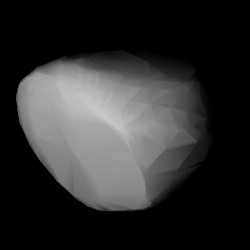
Back (1036) Ganymed ALS 1036 غانيميد Arabic 1036 جانيميد (كويكب) ARZ (1036) Ganymed BAR (1036) Ганімед Byelorussian 1036 Ganymed BJN (1036) Ganímedes Catalan (1036) Ганимед CE 1036 Ganymed Danish (1036) Ganymed German
 Shape model of Ganymed from its lightcurve | |
| Discovery[1] | |
|---|---|
| Discovered by | W. Baade |
| Discovery site | Bergedorf Obs. |
| Discovery date | 23 October 1924 |
| Designations | |
| (1036) Ganymed | |
| Pronunciation | /ˈɡænəmɛd/ |
Named after | Ganymede[2] (Greek mythology) |
| 1924 TD · 1952 BF 1954 HH | |
| Amor[1][3] · NEO | |
| Adjectives | Ganymedean /ɡænəˈmiːdiən/ |
| Orbital characteristics[3] | |
| Epoch 23 March 2018 (JD 2458200.5) | |
| Uncertainty parameter 0 | |
| Observation arc | 93.69 yr (34,221 d) |
| Aphelion | 4.0837 AU |
| Perihelion | 1.2421 AU |
| 2.6629 AU | |
| Eccentricity | 0.5335 |
| 4.35 yr (1,587 d) | |
| 183.36° | |
| 0° 13m 36.48s / day | |
| Inclination | 26.693° |
| 215.55° | |
| 132.45° | |
| Earth MOID | 0.3415 AU (133 LD) |
| Mars MOID | 0.03287 AU[1] |
| Physical characteristics | |
| Dimensions | 39.3 km × 18.9 km[4] |
| 31.66±2.8 km[5] 35.01±0.78 km[6] 37.675±0.399 km[7][8][9] | |
| 10.297 h[10][11] | |
| 0.218[8][9] 0.243[6] 0.2926[5] | |
| Tholen = S[4] SMASS = S[4][10] S[4][12][13] U–B = 0.417[3] B–V = 0.882±0.008[12] V–R = 0.515±0.004[12] V–I = 0.981±0.005[12] | |
| 9.45[1][3][5][6][8][9] 9.50[10][14] | |
1036 Ganymed, provisional designation 1924 TD, is a stony asteroid on a highly eccentric orbit, classified as a near-Earth object of the Amor group. It was discovered by German astronomer Walter Baade at the Bergedorf Observatory in Hamburg on 23 October 1924, and named after Ganymede from Greek mythology.[1][2] With a diameter of approximately 35 kilometers (22 miles), Ganymed is the largest of all near-Earth objects but does not cross Earth's orbit. The S-type asteroid has a rotation period of 10.3 hours. In October 2024, it is predicted to approach Earth at a distance of 56,000,000 km; 35,000,000 mi (0.374097 AU).[15]
- ^ a b c d e Cite error: The named reference
MPC-objectwas invoked but never defined (see the help page). - ^ a b Cite error: The named reference
springerwas invoked but never defined (see the help page). - ^ a b c d Cite error: The named reference
jpldatawas invoked but never defined (see the help page). - ^ a b c d Cite error: The named reference
Ferretwas invoked but never defined (see the help page). - ^ a b c Cite error: The named reference
SIMPSwas invoked but never defined (see the help page). - ^ a b c Cite error: The named reference
AKARIwas invoked but never defined (see the help page). - ^ Cite error: The named reference
Mainzer-2011was invoked but never defined (see the help page). - ^ a b c Cite error: The named reference
Mainzer-2016was invoked but never defined (see the help page). - ^ a b c Cite error: The named reference
WISEwas invoked but never defined (see the help page). - ^ a b c Cite error: The named reference
lcdbwas invoked but never defined (see the help page). - ^ Cite error: The named reference
Pilcher-2012gwas invoked but never defined (see the help page). - ^ a b c d Cite error: The named reference
Lin-2018was invoked but never defined (see the help page). - ^ Cite error: The named reference
Fieber-Beyer-2007was invoked but never defined (see the help page). - ^ Cite error: The named reference
Hahn-1989was invoked but never defined (see the help page). - ^ Cite error: The named reference
jpl-closewas invoked but never defined (see the help page).